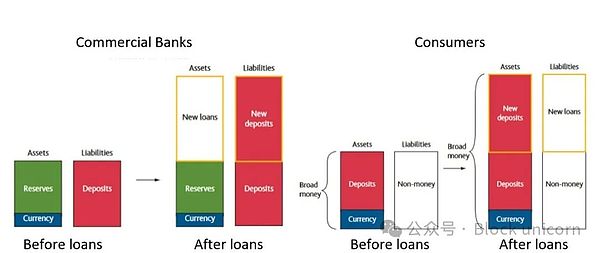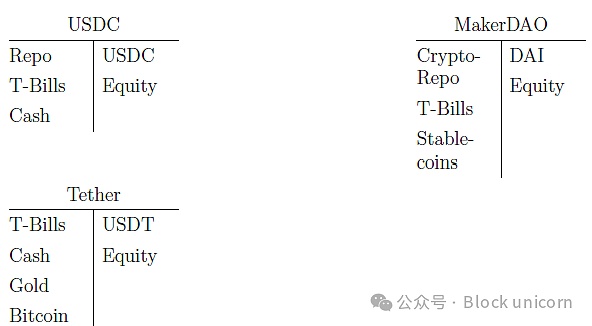Article author: Minerva Article compilation: Block unicorn
The first U.S. dollar-backed encryption since Tether launched Ten years have passed since the emergence of digital currency. Since then, the stablecoin has become one of the most widely adopted products in the cryptocurrency space and now has a market capitalization of nearly $180 billion. Despite such significant growth, stablecoins still face many challenges and limitations.
This article delves into the problems with existing stablecoin models and attempts to predict how we might end the monetary civil war.
1. Stablecoin = Debt
In-depth discussion Before that, let’s cover some basics to better understand what stablecoins are.
When I started researching stablecoins a few years ago, I was confused by people describing them as debt instruments. But as I dug deeper into how money is created in the current financial system, I began to understand this.
In the legal currency system, money is mainly generated when commercial banks (hereinafter referred to as "banks") provide loans to customers. But that doesn’t mean banks can create money out of thin air. Before money can be created, a bank must first receive something of value:your promise to repay the loan.
Suppose you need financing to buy a new car. You apply for a loan with your local bank, and once approved, the bank makes a deposit into your account that matches the loan amount. At this point new currency is created in the system.
When you transfer these funds to the person selling the car, the deposit may be transferred to another bank if the seller has an account with another bank . However, the money remains in the banking system until you start paying back the loan. Money is created through loans and destroyed through repayments.
Figure 1: Money creation through additional loans

Source: "Money Creation in the Modern Economy" (Bank of England)
Stablecoins work somewhat similarly. Stablecoins are created when an issuer issues a loan and are destroyed upon repayment by the borrower. Centralized issuers like Tether and Circle mint tokenized USD, which are essentially digital IOUs issued based on U.S. dollar deposits made by borrowers. DeFi protocols such as MakerDAO and Aave also mint stablecoins through loans, but this issuance is collateralized by crypto assets rather than fiat currencies.
Because their debt is backed by various forms of collateral, stablecoin issuers effectively act as crypto banks. Sebastien Derivaux, founder of Steakhouse Financial, explores this analogy further in his study “Cryptodollars and the Hierarchy of Money.”
Figure 2: Two-dimensional matrix of crypto dollars

Source: "Cryptodollars and the Hierarchy of Money", 2024 September
Sebastien uses two dimensional matrix to classify stablecoins.
Here are some noteworthy examples:
USDT: Mainly supported by off-chain reserves. Tether's model is a fractional reserve, as each USDT is not backed 1:1 by cash or cash equivalents such as Treasury bills, but also includes other assets such as commercial paper and corporate bonds.
USDC: USDC is also backed by off-chain reserves, but with USDT is different in that it maintains a fully reserve status (backed 1:1 by cash or cash equivalents). Another popular fiat-backed stablecoin, PYUSD, also falls into this category.
DAI: DAI is issued by MakerDAO and is reserved on the chain support. DAI is partially reserved through its over-collateralized structure.
Figure 3: Simplified balance sheet of current crypto-dollar issuers

Source: "Cryptodollars and Currency Levels" 》 (Cryptodollars and the Hierarchy of Money), September 2024
Like traditional banks, these crypto banks aim to achieve modest balance sheet risk by taking on , creating substantial returns for shareholders. The risk is high enough to be profitable, but not so high that it jeopardizes the collateral and risks bankruptcy.
2. Problems with the existing model
Although it is stable Coin has desirable characteristics such as lower transaction costs, faster settlement speeds, and higher returns than traditional financial (TradFi) alternatives, but existing models still face many problems.
(1) Fragmentation
According to RWA.xyz According to data, there are currently 28 active USD-pegged stablecoins.
Figure 4: Market share of existing stablecoins

Source: RWA.xyz
As Jeff Bezos famously said: "Your profit margin is my opportunity." While Tether and Circle continue to dominate the stablecoin market, the high interest rate environment in recent years has spawned a wave of new entrants seeking a piece of these high profits.
The problem with having so many stablecoin options is that although they all represent tokenized dollars, they are not interoperable. For example, a user holding USDT cannot seamlessly spend it at a merchant that only accepts USDC, even though both are pegged to the U.S. dollar. Users can exchange USDT for USDC through centralized or decentralized exchanges, but this adds unnecessary transaction friction.
This fragmented pattern is similar to the pre-central banking era, when individual banks issued their own banknotes. In that era, the value of bank notes fluctuated due to their credit stability and could even become worthless if the issuing bank failed. The lack of standardization of values results in market inefficiencies, making cross-regional trade difficult and costly.
The central bank was established to solve this problem. By requiring member banks to maintain reserve accounts, they ensure that banknotes issued by banks can be accepted at face value throughout the system. This standardization achieves what is known as "monetary unity," which allows all banknotes and deposits to be treated as equivalent, regardless of the creditworthiness of the issuing bank.
But DeFi lacks a central bank to establish monetary unity. Some projects, like M^0 (@m0foundation), are trying to solve interoperability issues by developing decentralized crypto-dollar issuance platforms. I personally have high hopes for their grand vision, but the challenges are significant and their success is still a work in progress.
(2) Counterparty risk
Imagine you are in J.P. Morgan (JPM) has an account. Although the official currency of the United States is the United States Dollar (USD), this account balance actually represents a bank note, which we can refer to as jpmUSD.
As mentioned earlier, jpmUSD is pegged to the U.S. dollar at a 1:1 ratio through JPM’s agreement with the central bank. You can exchange jpmUSD for physical cash or use it interchangeably within the banking system with bills from other banks such as boaUSD or wellsfargoUSD at a 1:1 rate.
Figure 5: Schematic diagram of the currency hierarchy

Source: #4 | Currency Classification: From Tokens to Stablecoins (Dirt Roads)
Just as we can stack different technologies to create digital ecosystems, various forms of currency can also be layered to build monetary hierarchies. The U.S. dollar and jpmUSD are both forms of currency, but jpmUSD (or "bankcoin") can be considered a layer on top of the U.S. dollar ("token"). Within this hierarchy, BankCoin relies on the trust and stability of the underlying token and is backed by a formal agreement between the Federal Reserve and the U.S. Government.
Fiat-backed stablecoins such as USDT and USDC can be described as a new layer on top of this hierarchy. They retain the essential qualities of bankcoins and tokens while adding the benefits of blockchain networks and interoperability with DeFi applications. While they act as an enhanced payments rail layer on top of existing currency stacks, they remain tightly tied to the traditional banking system and therefore introduce counterparty risk.
Centralized stablecoin issuers typically invest their reserves in safe and liquid assets, such as cash and short-term U.S. government securities. Although credit risk is low, counterparty risk is higher because only a small portion of bank deposits are insured by the Federal Deposit Insurance Corporation (FDIC).
Figure 6: Stablecoin price fluctuations during the SVB collapse

Source: "Stablecoins and Tokenized Deposits: Impact on Monetary Unity" (BIS)
For example, of the approximately $10 billion in cash held by Circle in regulated financial institutions in 2021, only $1.75 million (approximately 0.02%) It is protected by FDIC deposit insurance.
When Silicon Valley Bank (SVB) failed, Circle was in danger of losing most of its deposits with the bank. If the government does not take special steps to guarantee all deposits, including those above the $250,000 FDIC insurance limit, USDC could become permanently decoupled from the U.S. dollar.
(3) Yield: Race to the bottom
The dominant narrative around stablecoins during this cycle is the concept of “returning earnings to users.”
For regulatory and financial reasons, centralized stablecoin issuers retain all profits generated from user deposits. This creates a disconnect between the parties who actually drive value creation (users, DeFi applications, and market makers) and the parties who capture the revenue (issuers).
This discrepancy paves the way for a new wave of stablecoin issuers who use short-term wealth or tokenized versions of these assets to mint stablecoins and The basic income is redistributed to users through smart contracts.
While this is a step in the right direction, it also prompts issuers to slash fees in order to gain greater market share. The intensity of this battle for yield was evident when I reviewed the Spark Tokenization Grand Prix’s tokenized money market fund proposal. The Spark Tokenization Grand Prix aims to consolidate $1 billion in tokenized financial assets as collateral for MakerDAO.
Ultimately, yields or fee structures cannot be long-term differentiators, as they may converge toward the lowest sustainable rate needed to stay afloat. Issuers will need to explore alternative monetization strategies, as the issuance of stablecoins does not accumulate value by itself.
3. Predicting an unstable future
"Three Kingdoms" "The Romance" is a beloved classic in East Asian culture. It is set in the late Han Dynasty, a time when wars between warlords and wars broke out.
A key strategist in the story is Zhuge Liang, who proposed dividing China into three separate regions, each controlled by the three warring forces. Famous strategy. His "Three Kingdoms" strategy aimed to prevent any one kingdom from gaining dominance, thereby creating a balanced power structure to restore stability and peace.
I'm no Zhuge Liang, but stablecoins may benefit from a similar rule of thirds strategy. The future landscape may be divided into three areas: (1) payments, (2) revenue, and (3) the middle layer (everything in between).
Payments: Stablecoins provide a seamless, Low-cost cross-border transaction settlement method. USDC currently leads the way in this regard, and its partnership with Coinbase and Base Layer 2 may further solidify its position. DeFi stablecoins should avoid competing directly with Circle in the payments space and instead focus their efforts on the DeFi ecosystem where they have clear advantages.
Earnings: RWA protocols that issue income-based stablecoins should provide Ethena Learns, Ethena has cracked the secret to generating high-yielding and relatively sustainable returns through cryptocurrency-native and related products. Whether leveraging other delta-neutral strategies or creating synthetic credit structures that replicate traditional finance (TradFi) swaps, there is room for growth in this area as USDe faces a scalability ceiling.
Middle layer: Stable for decentralization with low returns coins, with the opportunity to unify decentralized liquidity. An interoperable solution would maximize DeFi's ability to match lenders and borrowers and further simplify the DeFi ecosystem.
The future of stablecoins remains uncertain. But a balanced power structure between the three parts could end the “currency civil war” and bring much-needed stability to the ecosystem. Rather than engaging in a zero-sum game, this balance will provide a solid foundation for the next generation of DeFi applications and pave the way for further innovation.
 Weatherly
Weatherly









